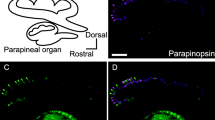Summary
Fluorescence Microscopy
Changes in the density of yellow autofluorescent and serotonincontaining pinealocytes in the rabbit pineal gland have been studied under different experimental conditions such as p-chlorophenylalanine, environmental lighting and permanent darkness, using fluorescence microscopy.
The yellow autofluorescent pinealocytes (Type II), particularly present in a circumscript area of the organ, increased in number during treatment of the animals with pCPA as well as during the night under environmental lighting conditions. This increase probably accurred at the cost of the decrease in number of serotonin-containing pinealocytes (Type I) in the same area, originally present. Moreover it could be demonstrated that under environmental lighting conditions both, the number of Type I and Type II cells, showed a day and night rhythm.
During continuous darkness the circadian rhythm in the serotonin content of the Type I cells persists. Evidently, this rhythm is not controlled by exogenous environmental lighting conditions but endogenously. In contrast to the persisting circadian serotonin rhythm, no such fluctuations could be observed in the yellow autofluorescing compound in the Type II cells.
Light Microscopy
Evidence is presented indicating that the yellow autofluorescent compound, present in the rabbit pinealocytes, is identical with a protein containing much tryptophan.
In the rabbit pineal gland three different patterns of intramural blood vessels can be distinguished which are, respectively, situated in (1) a thin cortex, (2) a medulla, and (3) a transition area of the gland situated between the cortex and the medulla, containing the Type I and Type II pinealocytes of population B (see introduction).
These studies revealed that the Type I and Type II pinealocytes of population B in close topographical contact with the intrapineal capillary system of the transition area.
Similar content being viewed by others
References
Axelrod, J.: Neural Control of indole metabolism in the pineal. The Pineal Gland, pp. 35–47 (Wolstenholme, F. E. W., andJ. Knight, eds.). A Ciba Foundation Symposium. 1971.
Balemans, M. G. M., andF. C. G. Veerdonk: Fluorescence of Indole derivates. Experientia23, 906–909 (1967).
Barka, T., andP. J. Anderson: Histochemistry, theory, practice and bibliography, pp. 182–202. New York-Evanston-London: Harper and Row, Publishers Inc. 1963.
Bloom, F. E., andN. J. Giarman: Fine structure of granular vesicles in pineal autonomic nerve endings after serotonin depletion. Anat. Rec.157, 351 (1967).
Bloom, F. E., andN. J. Giarman: The effects of p-cl phenylalanine on the content and cellular distribution of 5-HT in the rat pineal gland: combined biochemical and electron microscopic analysis. Biochem. Pharmacol.19, pp. 1213–1219. Pergamon Press. 1970.
Bruemmer, N. C., J. C. Carver, andL. E. Thomas: A Tryptophan histochemical method. Acta Histochemica5, 140–144 (1957).
Dickman, S. R., andA. L. Crocket: Determination of Tryptophan in blood and in protein. J. Biol. Chemistry220, 957–965 (1965).
Goldstein, M., andR. Frenkel: Inhibition of Serotonin Synthesis by Dopa and other Catechols. Nature233, 179–180 (1971).
Heene, R.: Histochemischer Nachweis von Katecholaminen und 5-Hydroxytryptamin am Kryostat-Schnitt. Histochemie14, 324–327 (1968).
Kappers, Ariëns J.: Survey of the innervation of the epiphysis cerebri and the accessory pineal organs of vertebrates. Progress in Brain Res.10, pp. 87–153 (Ariëns Kappers, J., andJ. P. Schadé, eds). 1965.
Koe, K., andA. Weissman: p-Chlorophenylalanine: a specific depletor of brain Serotonin. The J. of Pharmacol. and exp. Ther.154 (3), 499–516 (1966).
Owman, Ch.: Localisation of Neuronal and Parenchymal Monoamines under normal and Experimental conditions in the mammalian gland. Progress in Brain Res.10, pp. 423–453 (Ariëns Kappers, J., andJ. P. Schadé, eds.). 1965.
Romeis, B.: Mikroskopische Technik. München: Oldenbourg. 1948.
Shein, H. M., R. J. Wurtman, andJ. Axelrod: Synthesis of serotonin by pineal glands of the rat in organculture. Nature213, 730–731 (1967).
Sherridan, N. N., andJ. F. Keppel: The effect of p-chlorophenyl-alanine (pCPA) and 6-hydroxydopamine (6-HD) on ultrastructural features of Hamster pineal Parenchyma. Abstract in the Eighty Fourth annual session of the Am. Assoc. of Anat.427 (1971).
Smith, A. R.: The topographical relations of the rabbit pineal gland to the large intracranial veins. Brain Research30, 339–348 (1971).
Smith, A. R., J. F. Jongkind, andJ. Ariëns Kappers: Distribution and quantification of serotonin containing and autofluorescent cells in the rabbit pineal organ. General Comparative Endocrinology18, 364–375 (1972).
Snyder, S. H., M. Zweig, J. Axelrod, andJ. E. Fisher: Control of the circadian rhythm in serotonin content of the rat pineal gland. Proc. Natn. Acad. Sci. USA53, 310–315 (1965).
Udenfriend, S.: Fluorescence assay biology and medicine. Vol. II. New York-London: Academic Press. 1969.
Wurtman, R. J., J. Axelrod, G. Sedvall, andR. Y. Moore: Photic and Neural control of the 24-hour norepinephrine rhythm in the rat pineal gland. J. Pharmac. exp. Ther.157, 487–492 (1967).
Wurtman, R. J., H. M. Shein, J. Axelrod, andF. Larin: Incorporation of C14-tryptophan into C14-proteins by cultured rat pineals: Stimulation by L-norepinephrine. Proc. Natn. Acad. Sci. USA62, 749–755 (1969).
Author information
Authors and Affiliations
Rights and permissions
About this article
Cite this article
Smith, A.R., Ariëns Kappers, J. & Jongkind, J.F. Alterations in the distribution of yellow fluorescing rabbit pinealocytes produced by p-chlorophenylalanine and different conditions of illumination. J. Neural Transmission 33, 91–111 (1972). https://doi.org/10.1007/BF01260899
Received:
Issue Date:
DOI: https://doi.org/10.1007/BF01260899




